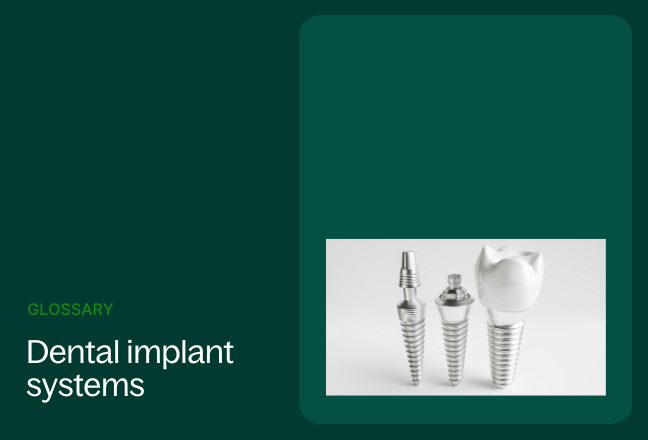What are immediate dentures?
Immediate dentures, also known as “temporary dentures,” are customized full-dentures (upper, lower, or both) prosthetic devices designed for immediate use following dental extractions. Modeled in anticipation of extractions, immediate dentures replicate the patient’s original teeth and bite.
Immediate dentures fulfill various functions: promoting aesthetic continuity, phonetic function, and masticatory efficiency. Additionally, immediate dentures help protect extraction sites from post-surgical complications during the healing process, and promote tissue retention and overall healing until adoption of a permanent restoration or prosthesis.
The pros and cons of immediate dentures
“Immediate dentures come into play when there’s no way [the patient] can afford a crown and bridge style restoration or an implant style restoration without it being an implant or full denture,” says Chad Van Maele, a Dandy lab technician with over 16 years of experience fabricating dentures. “They act as a Band-Aid,” he says, explaining that they help facilitate healing and protect extraction sites. “They definitely help avoid dry socket…that’s no fun at all.” But perhaps the most important aspect of immediate dentures, he says, is that “the patient has a smile day one, so they can smile more confidently and speak and be seen in public, versus a mouth full of open wounds.”
But, Van Maele notes, immediate dentures do have some major drawbacks. “When you first get [immediate dentures], they almost never fit great because the patient has just gone through major trauma,” says Van Maele. “Tissue will shrink and change shape and those immediate dentures will become loose and ill-fitting very quickly.” Which is why monthly relining is necessary. Van Maele also notes that, following extractions, patients newly-fitted with immediate dentures are “still gonna be on a soft food diet for a couple of weeks, if not months… they lose about 70% of their biting force, so those who expect that they’re gonna be eating corn on the cob and steak are more likely gonna be eating creamed corn and steak burger, cut up into little bits.”
Pros:
Immediate restoration – Immediate dentures provide immediate replacement for missing teeth on the same day as extractions, ensuring no extended period without teeth.
Preservation of aesthetics – Temporary dentures maintain the patient’s facial appearance. This can have a huge effect on self-confidence and reduces the likelihood of the prosthesis’ abandonment.
Functional continuity – Immediate dentures allow for continued phonetic function and masticatory efficiency, aiding in speech and eating during the healing period. Though, masticatory efficiency is limited, it is still better than exposed gums.
Preservation of oral structures – By protecting extraction sites, immediate dentures help prevent complications like dry socket and tissue loss.
Facilitates bite and size replication in permanent dentures – The immediate placement of temporary dentures allows the dentist to note the patient’s overall experience with a denture. Patients’ preferences and the overall look/function of the fabricated appliance serve as a dry-run of sorts, helping to refine the forthcoming permanent prosthesis.
Cons:
Need for adjustments – Chairside adjustments are necessary due to the dynamic changes in oral tissues during the six-eight month healing process during which immediate dentures will be worn.
Temporary nature – They serve as an interim solution and are ultimately replaced by more permanent dentures, hence their other name: temporary dentures. As their function is largely cosmetic and protective, immediate dentures are not a good replacement for permanents or implants.
Discomfort – Patients may experience discomfort while they heal when comparing immediate dentures vs permanent. Whereas permanent dentures are applied after recovery, the active healing process when immediate dentures are worn means they are likely to contact sensitive tissues. Immediate dentures may also trigger gag reflex in some sensitive patients.
Speech and eating challenges – Some patients may face challenges in speech as they adapt to the new dentures, especially with ‘s’ and ‘t’ sounds. Bite force is also limited with immediate dentures vs permanent. In addition, liquids can loosen the denture reducing its overall functionality, and some patients report attenuation in their sense of taste.
Cost – As they are not strictly necessary, immediate dentures incur cost in addition to that of surgery and permanent restoration.
The immediate dentures workflow
In the last few years, technology has fundamentally changed the possibilities for taking dental impressions, visualizing fitting, and fabricating oral appliances–immediate dentures are no exception. Below, the traditional, analogue workflow that you most-likely learned in school is outlined versus the newer digital alternative.
Note: With both digital and traditional workflows, the process begins with the same initial step: a patient undergoes a full preoperative assessment including a cleaning, evaluation of present overall oral health, imaging both for evaluative and aesthetic reference purposes, and a full medical history. This assessment culminates in the dentist making a recommendation for a long-term solution (i.e. permanent dentures, implants, snap-ons, etc).
The traditional workflow for immediate dentures
- Teeth are prepped.
- Upper and lower dental impressions are taken using trays and alginate (or other comparable material) from which a stone cast is made.
- Custom trays are fabricated for wash impressions (aka border molding). Wash impressions are taken.
- All impressions are inspected for any inclusions or defects–if any are present, Steps 1, 2, 3 must be repeated as needed.
- Impressions are shipped to the lab.
- Lab technicians hand fabricate occlusal wax rims.
- Wax rims are shipped back to the dentist.
- The patient returns for evaluation of the wax rims and tooth selection, the dentist noting any/all adjustments that must be made.
- Wax rim is shipped back to the lab.
- Using the notes from Step 5, reference images, and all dental impressions, the wax rim is fitted with acrylic teeth for a try-in.
- The wax try-in is shipped back to the dentist.
- The patient returns for an evaluation of the wax try-in. Notes and adjustments are made.
- The wax try-in is sent back to the lab.
- The immediate denture is hand crafted. Once finished, the immediate denture is inspected
- The immediate denture is shipped back to the dentist.
- The surgical appointment takes place.
- The immediate denture is placed and fitted.
The digital workflow for immediate dentures
- A scan of the patient’s mouth is taken using an intraoral scanner. This scan records the patient’s entire mouth including occlusal surfaces, gingiva, and bite in precise detail. These scans are automatically converted into a 3D model. Patient notes and/or feedback can be included as well. The scan is immediately sent electronically from the chairside to the dental lab.
- Scans are inspected by a lab technician observing any notes made on the 3D scan. Upon approval, the immediate denture is 3D printed. Once finished, the digital denture is refined and inspected for quality control.
- Immediate dentures are shipped back to the dentist.
- The surgical appointment takes place, and the immediate denture is fitted.
As you can see, the traditional workflow for immediate dentures necessitates at least four of patient visits over the course of months whereas the digital workflow can be completed in just two visits with a possible turnaround of a single week.
How long should a patient have immediate dentures?
A patient should have immediate dentures for the duration of their full convalescence, allowing all tissue to completely heal and natural shrinkage to take place–typically 6-8 months. During this timeframe, relining is common to maximize patient comfort and function. After a patient is deemed fully recovered, the switch to a more durable, more permanent prosthesis can safely be made.
Indications and contraindications for immediate dentures
Immediate dentures are not appropriate for all cases. Below, we will outline indications and contraindications for temporary/immediate dentures.
Indications for temporary dentures
Immediate dentures are ideal for any patient who will undergo complete upper, lower, or full mouth extractions and is otherwise healthy with no underlying conditions. While they are not a medical necessity and do not significantly increase bite strength, temporary dentures can reduce post-extraction pain and promote healing. They are a great choice for people who have concerns about facial aesthetics, speech clarity, and/or want to get used to the feeling of life with an oral prosthetic.
Contraindications for temporary dentures
Immediate dentures may not be suitable for patients who
- Only require extraction of a minimal number of teeth.
- Have active oral infections, severe periodontal disease, or suffer from uncontrolled systemic conditions or other significant medical issues/conditions that may complicate full post-operative recovery.
- Have inadequate bone support in the oral cavity.
- Have poor overall oral hygiene habits and/or a lack of willingness to adhere to post-operative care/follow-up appointments.
- Women in the late stages of pregnancy.
- Fully dentulous patients seeking a purely cosmetic measure.
Patient FAQs
Q: What do immediate dentures look like?
A: Immediate dentures look almost exactly like permanent dentures i.e. like the patient’s natural teeth.
Q: How long will it take to get used to temporary dentures?
A: This depends on the individual, but most patients report an initial adjustment time of two-three weeks.
Q: How long is the immediate dentures recovery time?
A: Immediate dentures should stay in place for 24 hours following extraction. Full recovery time depends on the progress of post-extraction healing; approximately six-eight weeks.
Q: How do immediate dentures stay in place?
A: Immediate dentures stay in place primarily using suction and liners. Commercially available oral fixatives may also be used.
Immediate dentures: A temporary solution
Immediate dentures are worn from the day of tooth extraction until the day you get your permanent new dentures, but not every patient is the right candidate for temporary dentures. If you’re a dentist, patient education is the best course of action to ensure that your patients know their options when they are getting teeth extracted for partial dentures or full dentures.











